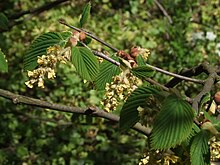Eared hazel
| Eared hazel | ||||||||||||
|---|---|---|---|---|---|---|---|---|---|---|---|---|

Spotted hazel ( Corylopsis spicata ) |
||||||||||||
| Systematics | ||||||||||||
|
||||||||||||
| Scientific name | ||||||||||||
| Corylopsis spicata | ||||||||||||
| Siebold & Zucc. |
The corylopsis spicata or spiked flowers hazel ( Corylopsis spicata ) is a bright yellow flowering shrub from the family of hamamelidaceae (Hamamelidaceae). The natural range of the species is in Japan. It is often used as an ornamental shrub.
description
The Ährige Scheinhasel is a shrub up to 2 meters high with hairy shoots. The leaves are divided into a petiole and a leaf blade. The stem is 1 to 2.5 inches long and woolly hairy. The leaf blade is simple, ovate or elliptical to obovate, pointed, with a heart-shaped or rounded base and a finely toothed, toothed margin. Six to seven pairs of nerves are formed. The underside of the leaf is blue-green and hairy.
The inflorescences are 2 to 4 centimeters long spikes of seven to ten flowers and a hairy inflorescence axis. The basal bracts are reddish green and bare. The bracts of the single flowers are usually hairy. The light yellow petals are obovate. The stamens are purple. The spotted hazel rarely blooms in February, usually from March to April.
Occurrence and location requirements
The natural range is in Japan on the island Shikoku . The spiked hazel grows in cool, moist forests on well-drained, fresh to moist, acidic to neutral, sandy or gravelly humus, moderately nutrient-rich soils in light-shaded, winter-mild locations. The species is sensitive to frost and avoids soils with a high lime content.
Systematics
The corylopsis spicata ( Corylopsis spicata ) is a kind of the genus of corylopsis ( Corylopsis ) in the family of hamamelidaceae (Hamamelidaceae). There it is assigned to the tribe Corylopsideae in the subfamily Hamamelidoideae. Philipp Franz von Siebold and Joseph Gerhard Zuccarini first described the species in 1836 in the Flora Japonica . The generic name Corylopsis is derived from Corylos , the generic name of the hazel , and from the Greek word "opsis" for "appearance". It corresponds to the German name Scheinhaseln and refers to the similarity of leaves and inflorescences with those of hazelnuts. The specific epithet spicata comes from Latin and means "ear-shaped".
use
The spotted hazel is often used as an ornamental shrub because of the decorative and fragrant flowers and the impressive autumn colors . Similar to garden forsythia and witch hazel, it blooms from late winter to spring and is therefore often used in hedges.
proof
literature
- Andreas Roloff , Andreas Bärtels: Flora of the woods. Purpose, properties and use. With a winter key from Bernd Schulz. 3rd, corrected edition. Eugen Ulmer, Stuttgart (Hohenheim) 2008, ISBN 978-3-8001-5614-6 , p. 220.
- Jost Fitschen: Woody flora . 12th, revised and expanded edition. Quelle & Meyer, Wiebelsheim 2007, ISBN 3-494-01422-1 , p. 430 .
- Helmut Genaust: Etymological dictionary of botanical plant names. 3rd, completely revised and expanded edition. Nikol, Hamburg 2005, ISBN 3-937872-16-7 (reprint from 1996).
Individual evidence
- ↑ German name after Roloff et al .: Flora der Gehölze , p. 220
- ^ German name according to Fitschen: Gehölzflora , p. 430
- ↑ a b c d Roloff et al .: Flora der Gehölze , p. 220
- ↑ a b Corylopsis spicata. In: Germplasm Resources Information Network (GRIN). United States Department of Agriculture, accessed April 15, 2012 .
- ↑ Exactly: Etymological Dictionary of Botanical Plant Names , p. 180
- ↑ Exactly: Etymological Dictionary of Botanical Plant Names , p. 603
- ↑ Corylopsis spicata. Missouri Botanical Garden, accessed April 15, 2012 .
Web links
- Thomas Meyer: Data sheet with identification key and photos at Flora-de: Flora von Deutschland (old name of the website: Flowers in Swabia )
- Corylopsis spicata. In: The Plant List. Retrieved April 15, 2012 .


